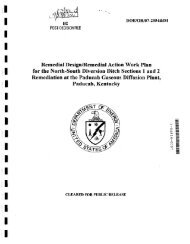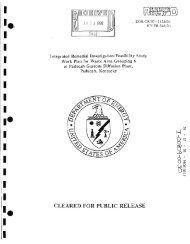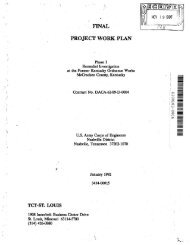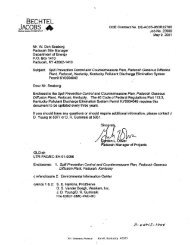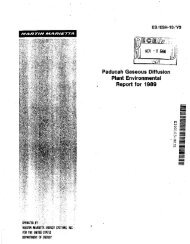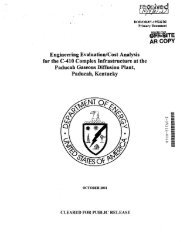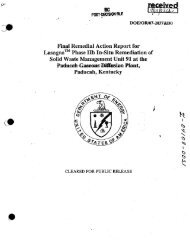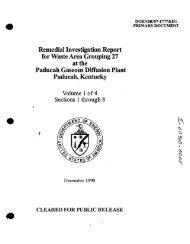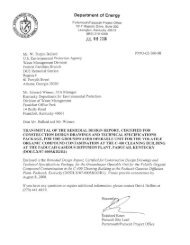1 - paducah environmental information center
1 - paducah environmental information center
1 - paducah environmental information center
Create successful ePaper yourself
Turn your PDF publications into a flip-book with our unique Google optimized e-Paper software.
Paducah Site<br />
Field Sampling Quality Control<br />
Data Quality Objectives and Sample<br />
Planning<br />
From the point of conception of any<br />
sampling program, DQOs play· an important<br />
role. The number of samples, location of<br />
sampling sites, sampling methods, sampling<br />
schedules, and coordination of sampling and<br />
analytical resources to meet critical completion<br />
times were part of the. DQOs and are documented<br />
in the Environmental Monitoring Plan (BJC<br />
1998).<br />
Each sample location and sample collected<br />
was assigned a unique identification number<br />
which consists of an alphanumeric sequence.<br />
Each segment . of the sequence was used to<br />
designate <strong>information</strong> concerning the location<br />
from which a sample was collected. In order to<br />
progress from planning to ,implementing the<br />
DQOs, an. analytical statement of work (SOW)<br />
for the analytical laboratory was generated from<br />
a system'within, the Paducah Integrated Data<br />
System. ,From . this system, the Project<br />
Environmtmtal Measurements System (PEMS),<br />
an electronic 'database used for streamlining<br />
fidd-generated and laboratory-generated data,<br />
was populated with sample identification<br />
numbers, sampling locations, sampling methods,<br />
analytical parameters, analytical methods, and<br />
container and preservative requirements. This<br />
<strong>information</strong> was used to produce sample bottle!<br />
jar labels and chain-of-custody forms for the<br />
sampling event.<br />
,Field Measurements<br />
Field measurements for the groundwater<br />
and surface water monitoring program were<br />
collectedreal.:.time in, the field and consisted of<br />
water ievet measurements, pH, conductivity,<br />
flow rates, . turbidity, temperature, dissolved<br />
oxygen, total residual chlorine, and barometric<br />
pressure. Environmental conditions· such as<br />
temperature and weather were also recorded.<br />
Field measurements were taken and downloaded<br />
electronically or recorded on appropriate field<br />
forms or in logbooks, and input into PEMS on a<br />
weekly or other appropriate basis.<br />
Sampling Procedures<br />
Samples were collected using mediaspecific<br />
procedures which are written according<br />
to EPA-approved sampling methods. Sample<br />
media consisted of surface water, groundwater,<br />
sediment, and biota, such as fish or deer. Sample<br />
<strong>information</strong> collected during the sample event<br />
consisted of the following: sample identification<br />
number, station (or location), data collected,<br />
time collected, person who performed the<br />
sampling, etc. This <strong>information</strong>. was recorded in<br />
the logbooks and on the chain-of-custody form<br />
and sample container label, arid input directly<br />
into PEMS on a weekly or other appropriate<br />
basis. Chain-of-custody forms, were maintained<br />
from the point of sampling, and samples were<br />
properly protected until they were placed in the<br />
custody of an analytical laboratory.<br />
Field Quality Control Samples<br />
The QC program for both groundwater and<br />
<strong>environmental</strong> monitoring activities specified a<br />
minimum target rate of 5%, or one per 20<br />
<strong>environmental</strong> samples, on field QC samples.<br />
Table 11.1 shows the types of QC samples<br />
collected and analyzed. Analytical results of<br />
field QC samples were evaluated to determine if<br />
the sampling event had, in some way, affected<br />
the sample results.<br />
Analytical Laboratory Quality<br />
Control<br />
Analytical Procedures<br />
When available and appropriate for the<br />
sample matrix, SW -846 methods were used for<br />
sample analysis. When SW -846 methods were<br />
11-2<br />
Quality Assurance



